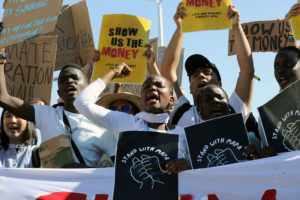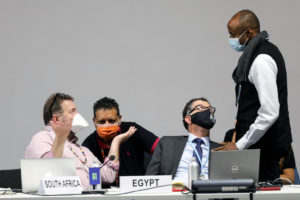
Analysis: Which countries have sent the most delegates to COP27?
Robert McSweeney
11.09.22Robert McSweeney
09.11.2022 | 4:33pmAfter the Covid-delayed, record-breaking COP26, which saw almost 40,000 delegates head to Glasgow, the 27th Conference of the Parties (COP27) is now underway in Sharm el-Sheikh in Egypt.
According to the UN’s provisional list of participants, more than 33,000 delegates have registered for COP27, making it potentially the second-largest summit in COP history.
Dubbed “Africa’s COP”, Carbon Brief analysis shows that record numbers of participants from African nations have registered for COP27 – as well as from least developed countries and small island states. Similarly, the number of NGO observers is provisionally the second-highest in COP history.
However, the run up to this year’s summit has been dogged by accusations of inflated hotel prices and concerns over surveillance, which may affect how many of these registered participants have actually been able to attend. The final COP27 participant list will not be published until after the summit has ended.
In this article, Carbon Brief delves into the provisional data, revealing that the United Arab Emirates has registered the largest party delegation this year. At more than 1,000 people, UAE’s delegation is almost twice the size of the next biggest, Brazil.
The gender balance across all party delegations at COP27 is 63% male to 37% female, which is similar to recent COPs. And there are just two all-male delegations this year – the fewest of any climate COP.
(Update 02/12/2022: The UNFCCC has now published the final COP27 participant lists. A total of 49,704 people attended, meaning that COP27 actually surpassed COP26 status as the largest in history by more than 10,000 participants.)
Second-biggest COP
According to the provisional list published by the United Nations Framework Convention on Climate Change (UNFCCC), 33,449 participants have registered for COP27.
Provisionally, this makes Sharm el-Sheikh the second-most well-attended climate COP in history. COP26 in Glasgow remains the most well-attended COP, with a final tally of 38,457. (See Carbon Brief’s analysis of COP26’s provisional figures from last year.) COP21 in Paris follows in third (30,372) and COP15 in Copenhagen in fourth (27,301).
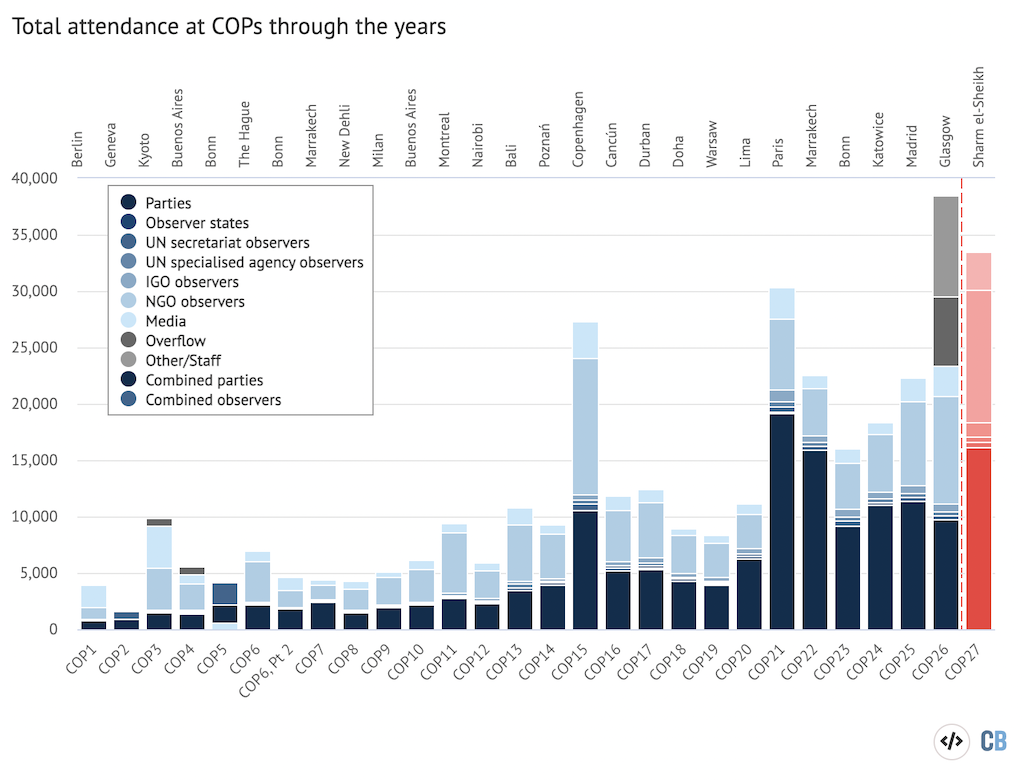
It is worth emphasising that these are provisional figures, based on the delegates that have registered for the summit. The UNFCCC will release the final figures – based on participants collecting a physical badge at the venue – after the summit has closed.
For example, the UK delegation includes both its current and previous prime ministers, as well as recently deposed business secretary Jacob Rees-Mogg.
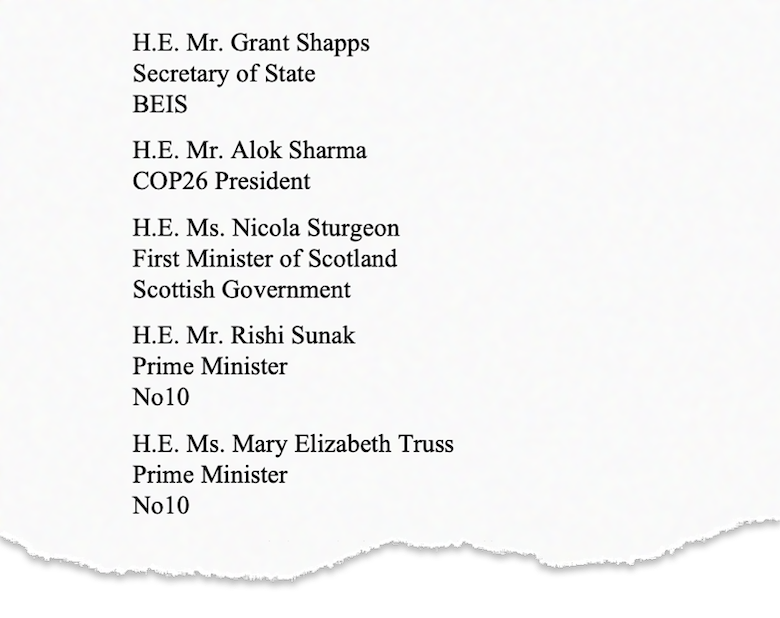
The largest group at COP26 is for delegates representing parties. These are nation states, plus the European Union, that have ratified the Convention and play a full part in negotiations. This group adds up to 16,118 delegates.
For the first time in the history of COPs, there are no “observer” states – those which have not completed ratification. Since COP22 in Marrakech in 2016, the only remaining observer state had been the Holy See – the government of the Roman Catholic Church, which operates from Vatican City State and is led by the pope as the bishop of Rome.
In June, the Holy See released a statement announcing its accession to the Convention and the Paris Agreement. And in a message to the COP27 leaders’ summit, Cardinal Pietro Parolin, Holy See secretary of state, said:
“This is the first UNFCCC session to which the Holy See participates as a state party to both the Convention and the Paris Agreement. This important step is consistent with Pope Francis’s announcement in 2020 that the Holy See would commit to the goal of net-zero emissions.”
With a delegation of six men and two women, the Holy See’s delegation is – for only the second time – bringing more than one female delegate to the COP.
The next-largest group is that of non-governmental organisations (NGOs), which totals 11,711 participants from 1,751 organisations. This is the second-largest group of NGO participants in the history of the COP, behind the 12,048 that attended COP15 in Copenhagen in 2009.
Despite the high number of registered NGO delegates, many civil society groups have criticised the Egyptian government over “exorbitant” hotel costs and fears around surveillance of delegates. The final participant lists will reveal how many participants from NGOs have been able to attend.
Along with the NGOs, there are several other groups that fall into the category of “observer organisations” – such as those participants representing UN bodies, intergovernmental organisations, other agencies and business representatives. These total 2,270 registered delegates.
The final group of COP participants is the media. There are 3,350 people registered as media for COP27, representing 1,306 organisations. This is second only to the 3,712 media delegates that attended COP3 in Kyoto in 1997. (However, it is worth noting that the actual number of media delegates that attend COP is usually lower than shown in the provisional list. For example, 3,781 registered for COP26, but only 2,602 attended.)
Next year’s hosts
In addition to the overall totals, the UNFCCC also publishes a breakdown of each party and observer delegation by name. From these lists, Carbon Brief has calculated the size of each named party delegation.
(While these provisional lists do not typically name all registered participants, the COP27 list does. However, the final list will also include party “overflow” delegates, which parties can nominate without their names appearing on the official list. There are also other “staff” and “temporary” participants at COPs that are not named in the lists.)
The largest delegation for COP27 is from the UAE, which has registered 1,073 delegates. This is the second-largest delegation in COP history after Morocco’s mammoth 1,591-strong representation at COP22, which it hosted.
UAE’s delegation is almost 10 times as large as the one it brought to COP26 (116). However, this is perhaps unsurprising considering it has been selected to host COP28 next year.
In second is Brazil, with a delegation of 574. Carbon Brief’s analysis of how delegations have changed across all COPs since the 1990s has shown that Brazil brings, on average, the largest named delegation.
After Brazil, the next largest delegation is the Democratic Republic of Congo (459), followed by Kenya (386) and Canada (377). Rounding out the top 10 is Zimbabwe (264), Senegal (245), Uganda (241), Republic of the Congo (237) and Iraq (235). Iraq’s delegation is almost three times as big as the one it took to COP26.
(It is worth noting that some countries allocate some of their party badges to NGOs, which can artificially inflate the size of their official delegation.)
The map and chart below present the delegation size and gender balance (see section below for details) for all the countries registered for COP27. The darker the shading, the more delegates that country has signed up. Mouse over the countries to see the number of delegates and the population size.
Africa’s COP
As hosts, Egypt has a delegation of 155, which is its largest at a COP to date.
The average delegation size across all African nations is 133 – comfortably the largest in COP history. At the last African COP in Morocco, the average delegation from African countries was 101. At COP26, the average size was 59.
Similarly, the average size of registered delegations for both small-island developing states (SIDS) and least developed countries (LDCs) are the largest in COP history. The average delegation size for SIDS is 36 at COP27, compared to 22 at COP26. For LDCs, the average delegation is 113-strong in Sharm el-Sheikh, compared to 50 in Glasgow.
As with the NGO participants, the final lists will show how many delegates from global-south countries have actually been able to attend.
Not all parties have registered a delegation for COP27. For the second year in a row, both Afghanistan and Myanmar have not sent a delegation to COP, while Saint Vincent and the Grenadines is also not on the provisional list. Kiribati, which did not send a delegation to COP26, has registered 29 people for COP27.
The country with the largest drop off in delegation size since Glasgow is Bangladesh, which has been reduced by 152 people – from 220 at COP26 to 68 at COP27. The next largest drop is in the UK’s delegation, which was 229 people in Glasgow and is 93 in Sharm el-Sheikh.
Gender balance
The UNFCCC’s list provides the name and title of each registered participant. Therefore, it is possible to work out the balance of men to women in the delegations that each country has sent to Egypt.
(It should be noted that the gender balances presented here are based on the titles designated by UNFCCC and not by Carbon Brief. In addition, Carbon Brief recognises that gender is not best categorised using a binary “male” or “female” label and appreciates that the UNFCCC’s lists may not be wholly accurate.)
Over the history of the COPs, the gender balance of named party delegations has gradually become less unequal. While the average delegation at COP1 was 88% male and 12% female, this has shifted over time. For example, COPs 23 to 25 all had an average gender balance of 62% male to 38% female, while COP26 had a balance of 64%-36%.
The provisional gender balance of COP27 is similar, clocking it at 63% male to 37% female.
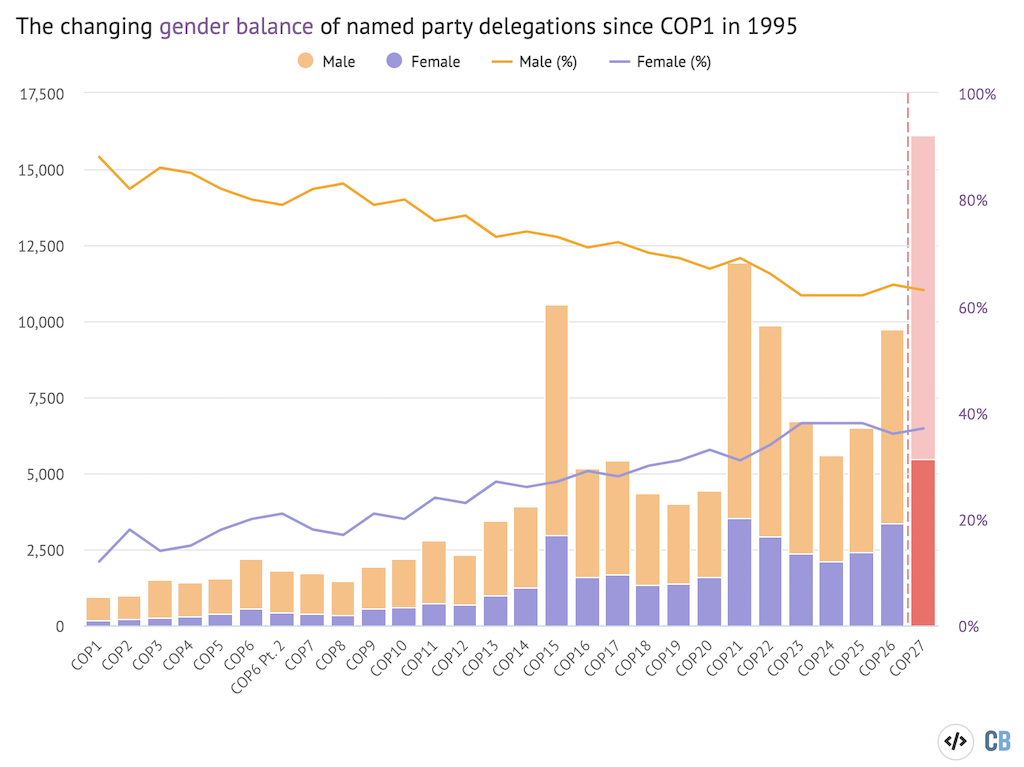
There are two all-male delegations registered for COP27 – North Korea (four delegates) and Turkmenistan (five). This is a far cry from the first COP in Berlin in 1995, where 105 of the 166 delegations were all-male.
There are no all-female delegations at COP27, although 26 parties have more female delegates than male.
The most female-led delegations are Niue (77% female to 23% male), Estonia (71%-29%) and Panama (70%-30%). The US (58%-42%), Australia (57%-43%) and UK (54%-46%) all have more women than men in their delegations.
There are seven parties with a 50-50 gender balance – Bosnia and Herzegovina, Cuba, Germany, Latvia, Slovenia, South Korea and Suriname.
The full list of COP27 party delegation sizes and their gender balances can be found here.




